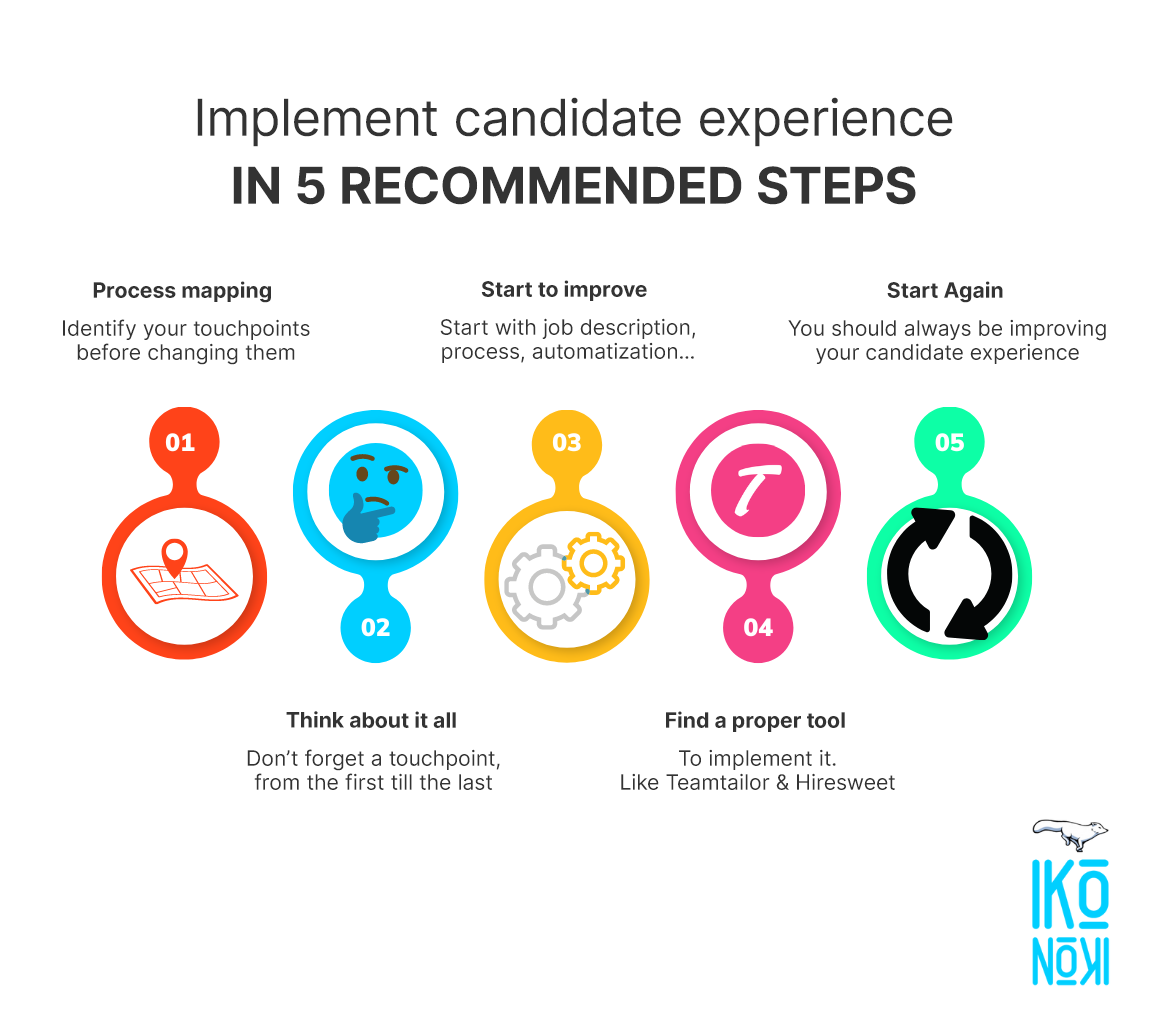Things you wished you knew about candidate experience


Léo Bernard
Léo Bernard is an HR entrepreneur that focuses on recruitment. He helps recruiters, managers and founders to level up their recruitment game through a unique bootcamp called “T-Shaped Recruiter”. He also help companies in general to tackle their recruitment challenges.
Candidate Experience is the hot topic on everyone’s lips.
Candidates are respected all around the globe. Most ATSs are made with candidates in mind. Candidates love recruiters so much that they share their love for them daily on LinkedIn.
Does that sound a little off to you? Well, because it’s not true!
The topic is entering the debate slowly. You can still see a steady increase when you look for the query “candidate experience” on Google Trends. It’s more and more being searched for whereas 10 years ago, it was not a subject at all!
However, you see a lot of things about it and you don’t really know what to remember, how to start, how much it costs, and if you should even focus on this aspect when you are already struggling with Sourcing, Employer branding, Hiring managers management and millions of other things. Let me tell you the things you wish you knew sooner about candidate experience.
In this article, we will discuss :
1/ The true cost of candidate experience
2/ Candidate experience is not what you think
3/ When does it start and stop?
4/ How to implement a proper experience?
1/ The true cost of candidate experience
First things first, it is one of the least expensive things in recruitment, you don’t need an expensive tool, you don’t need to invest in creative agencies, you don’t need to spend much time on it.
Candidate experience is all about the way candidates feel across the process. From the first touchpoint they have until the last one.
Before continuing on the price of it, let me tell you about a Virgin Media case.
Long story short, a candidate named Camille had a really negative candidate experience. She decided to cancel her subscription to the service because of that and so did some of her acquaintances.
The HR team decided to calculate the global cost of a negative candidate experience:
Then came the easy calculation: if there were 123,000 rejected candidate each year, and 6% canceled their monthly Virgin Media subscription, you end up with about 7,500 cancellations. Multiply that by the £50 ($60) subscription fee and by 12 months, and Johnson realised Virgin Media was losing £4.4 million per year, the equivalent of $5.4 million.
5.4 Million dollars!
So, if investing in candidate experience does not cost you much, not investing in it can cost you millions!
(More about the Virgin case on this article)
“Ok you’ve got me Léo, so how much should I invest in it?”
Not much, mostly time actually.
First thing is to map your entire process through a tool like Miro or Whimsical to find out how many touch points you have and how good your candidate experience is at every step.
Then, you can improve your candidate experience step by step. But we’ll touch on that a bit later.
First, let’s talk about a tiny difference between the different terms:
2/ Candidate Experience is not what you think
There is a difference between candidate experience, engagement and care.
Candidate experience is everything that happens from the first touchpoint until the last one. It covers the whole process and covers many aspects.
Candidate care is all about the extra love you give to your candidates. The little differences that will make your candidate love you in return. Candidate care and experience influence each other but candidate care is just a part of the experience.
Candidate engagement is also part of the candidate experience. This is how you keep in touch, how you manage to get your candidates active and engaged. You can be good at engagement but still have a bad experience even though it will obviously help!
“Ok ok, so many different things to process. Just tell me when to start and when to stop it”
Sure thing, let’s go!
3/ When does the candidate experience start and stop?
Bad news is: It never stops.
Good news is: It’s in your best interest.

Candidate experience starts with the job description/the career page
Your website has to be accessible, clear, and inclusive with good copywriting.
And for your job description: the same! And here transparency is key. The job description should stick to reality and should not overpromise.
Also, you should stick to the plan. For instance, if you write that the process is composed of 4 steps, don’t add a fifth one in the middle of the process! That’s not fair to your candidates.
During the interview, the experience should be as smooth as possible
You can send a guide (or at least an email) in advance to explain how it will go, what will happen, how candidates will be evaluated and other important pieces of information.
Once you are in a job interview, you should be the best version of yourself. Get there on time, smile, be respectful and transparent (And if you’re adding the candidate care touch, make the candidate feel special, like they are the only one in the process!)
And between each step of the process, you should share the news with candidates, every time you get any. And if you don’t have news, you can share that too, they’ll understand.
Once the process is done, you can still deliver a proper experience
When you say “No” to candidates, you can make it a fair experience. One of the reasons why candidates are mad at recruiters is due to a sense of “injustice” and if you are fair in your feedback, this feeling won’t appear and they will thank you instead.
Once it’s over, it’s not really over. At least I recommend you not to let that happen! A candidate of today is either a client or a candidate of tomorrow. You can stay in touch with them through a proper ATS (like Teamtailor) or by adding a CRM tool like Hiresweet to your recruitment stack to “Nurture” them.
That is why I said earlier that candidate experience never stops!
“Hmmm, that’s great but how can I implement it? Seems like a lot of time and I don’t know where to start”
I know, but it’s not that hard, let’s jump into that!
4/ How to implement candidate experience properly?
I recommend focusing on these 4 aspects to start with : Job description/Application process/Automatisation/Post process
When drafting a Job description, I suggest you focus on what your candidate really wants. Sorry to tell you that but they are more interested in the salary they will get, the responsibilities they will have and the job in detail rather than your company value and the fact that you are a leader in your field. (You can find a LinkedIn study about it here)
For the application process, it used to be really painful where you had to create a candidate account for every company you were applying to and you had to fill up all your experiences and studies. It was at least 10 to 15 minutes spent per company. Today, most of the ATS include a much faster process. But you can customise it to your needs.
Automatisation now. One of the reasons why candidate experience is often perceived as negative by candidates is simply because
- Recruiters forget
- There is a lot of wasted time with scheduling
- Candidates are not regularly updated
When I switched from Greenhouse to Teamtailor a few years ago, this is one of the features I loved the most. You can create different types of automatisation at every step of the process. An action that is triggered whether when a candidate is being moved to a new stage or when the candidate is being rejected.
And finally the post process part. A lot of candidates are simply sleeping in your ATS. They applied a while ago. You rejected them. And you will never talk to them ever again either because they will forget about you or you will forget about them. Teamtailor includes a “Connect” and a “Nurture” feature. The “Connect” feature allows candidates to “follow” your company and get notified every time a job in their field is being published. The “Nurture” feature allows you to create a campaign to target candidates (your “silver medalists” for instance so that they will receive emails from you whenever you want and with your own content).
“Ok ok, gotcha, but it’s not clear, I want to see it, how does it work in real life?”
Alright, Let me show you all of that on Teamtailor:
And that is it for today. I hope that you enjoyed your “reader” experience and that you are convinced that the best time to focus on your candidate experience is now!
I’d be happy to continue the discussion on Linkedin.
![]()
5 ways to improve your job postings
Your job posting is often the first impression your candidates are going to get of your company. We’ll go through a few quick and easy things you can do to improve your job postings and convert more candidates.
![]()
How to measure your candidate experience
37% of HR professionals said that candidate experience was their main measure of success. But how do you actually measure candidate experience?
![]()
How AI can make recruitment more human
When used correctly, AI can be used to ease the recruiter workload and improve candidate experience. Here our some key takeaways from our latest talk.


